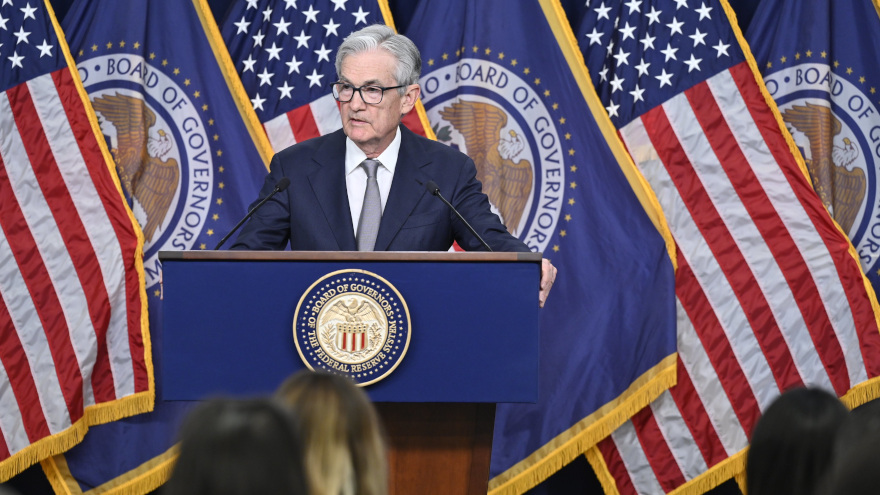UPDATED: 4 economists react to Fed’s expected rate holding

Chair Jerome Powell reads his opening statement and answers reporters’ questions at a press conference on Wednesday in Washington, D.C. Photo courtesy of the Federal Reserve.
ADESA chief economist Tom Kontos shared a similar reaction with SubPrime Auto Finance News as his expert brethren, saying the Federal Reserve voting unanimously to keep the federal funds rate at 5.25% to 5.5% was to be expected.
“Moreover, the Fed’s indication that further rate tightening remains a possibility strikes me as prudent, considering the possibility that inflation could reverse its recent declines and remains above-target,” continued Kontos, who also is set to appear at Used Car Week, which begins on Monday in Scottsdale, Ariz.
Appearing at a news conference on Wednesday afternoon, Fed chair Jerome Powell reiterated many of the points of how policymakers reached their latest decision.
“Today, we decided to leave our policy interest rate unchanged and to continue to reduce our securities holdings,” Powell said. “Given how far we have come, along with the uncertainties and risks we face, the committee is proceeding carefully. We will make decisions about the extent of additional policy firming and how long policy will remain restrictive based on the totality of the incoming data, the evolving outlook, and the balance of risks.
“Recent indicators suggest that economic activity has been expanding at a strong pace, and well above earlier expectations,” he continued. “The labor market remains tight, but supply and demand conditions continue to come into better balance.
“The Fed’s monetary policy actions are guided by our mandate to promote maximum employment and stable prices for the American people,” Powell went on to say. “My colleagues and I are acutely aware that high inflation imposes significant hardship as it erodes purchasing power, especially for those least able to meet the higher costs of essentials like food, housing, and transportation. We are highly attentive to the risks that high inflation poses to both sides of our mandate, and we are strongly committed to returning inflation to our 2 percent objective.”
How the Fed reaches its goals does concern Cox Automotive economist Jonathan Smoke, who offered his reaction to the latest actions through his blog. Smoke echoed Kontos’ point that the Fed keeping rates steady was expected.
“The economy has resisted a recession thus far, while the auto market has benefitted from pent-up demand. A strong labor market has enabled real wage gains for consumers over the last several months as inflation has come down from troublesome levels last year. With lower prices on new vehicles and depreciation returning to used vehicles, affordability has modestly improved despite higher rates,” Smoke wrote in his analysis.
“However, if we do see rates rise by another 0.5-1% caused in part by continued quantitative tightening (QT), the Fed risks sending the U.S. economy into recession, resulting in job losses. Next year’s auto market depends more on that than on short-term rate policy,” he went on to say.
Furthermore, the expert duo at Comerica Bank — chief economist Bill Adams and senior economist Waran Bhahirethan — also noted that they expected the Fed to proceed as it did this week while offering their expectations for what policymakers might do for the remainder of the year and into 2024.
“Following the Fed’s changes to their policy statement and chair Powell’s subtly altered forward guidance, as well as the recent run-up in long-term interest rates, Comerica is forecasting for the Fed to hold the fed funds target steady at their next few decisions,” Adams and Bhahirethan said.
“It is becoming more likely that the Fed’s next policy move will be a rate cut. Comerica’s November interest rate forecasts will show the federal funds rate steady through May of next year, and the Fed cutting interest rates by a quarter percentage point at the June, September, and December 2024 rate decisions, to end 2024 with the funds target at a range of 4.50% to 4.75%,” they went on to say.
On Friday, S&P Global Ratings offered its projection about what the Fed might do.
“Whether the Federal Open Market Committee (FOMC) is done with rate hikes will depend on a few factors — namely, progress on lowering inflation, and the state of labor market and financial conditions. For now, we maintain our previous assumption that there will be one more rate hike of 25 basis points in December,” S&P Global Ratings said in a news release.
“For 2024, we continue to expect economic growth to come in below trend and inflation to improve toward the Fed’s 2% target. The Fed will hold the policy rate steady through the first half of the year, letting passive tightening of real rates continue through disinflation, after the assumed December hike. It’s then likely to begin cutting rates in the second half of 2024 as unemployment starts to rise and inflation nears 2%,” analysts went on to say.


